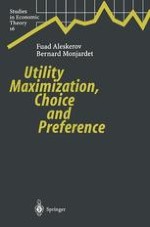2002 | OriginalPaper | Buchkapitel
Utility Maximization Within a Constant Threshold or a Threshold Depending on One Alternative
verfasst von : Professor Fuad Aleskerov, Professor Bernard Monjardet
Erschienen in: Utility Maximization, Choice and Preference
Verlag: Springer Berlin Heidelberg
Enthalten in: Professional Book Archive
Aktivieren Sie unsere intelligente Suche, um passende Fachinhalte oder Patente zu finden.
Wählen Sie Textabschnitte aus um mit Künstlicher Intelligenz passenden Patente zu finden. powered by
Markieren Sie Textabschnitte, um KI-gestützt weitere passende Inhalte zu finden. powered by
In Chapter 2 we have shown that the classic utility maximization model is equivalent to the pair-dominant choice model, with the corresponding binary relation being a weak order. The important property of a weak order is that the indifference relation of a weak order is transitive since it is an equivalence relation. But in Chapter 1 we discussed several examples in which the indifference relation associated with a preference relation is not transitive. In these examples the intransitivity of the indifference relation leads to the insensitivity of the utility evaluation. Now, in Chapter 3, we show how the classic paradigm of binary comparison and optimizational choice can be extended to take account of this insensitivity. In order to do this, we introduce an ε-wide insensitivity zone for the comparison of the utility values and for the choice. Thus, an alternative x is preferred to an alternative y only if its utility value exceeds the utility value of y from the threshold value ε (i.e., if u(x) > u(y) + ε). Throughout this Chapter the value of threshold ε is assumed to be either a positive constant or a function ε(ix) which depends on each alternative (while in other chapters more general definitions of ε will be considered). In the case where the threshold function is non-negative, in Section 3.2 this model of utility maximization is called the interval choice model.
